Developmental Features, Influencing Factors, and Formation Mechanism of Underground Mining–Induced Ground Fissure Disasters in China: A Review
Abstract
1. Introduction
2. Investigation of Mining–Induced Ground Fissures in China
3. What Is a Mining–Induced Ground Fissure?
3.1. Development Process of Mining–Induced Ground Fissures
3.1.1. Formation and Expansion of Rock Fractures
3.1.2. Surface Deformation and Ground Fissure Formation Stage
3.1.3. Dynamic Development Stage of Ground Fissures
3.2. General Characteristics of the Development of Mining–Induced Ground Fissures
3.3. Types of Mining–Induced Ground Fissures
3.4. Several Characteristic Parameters Describing Mining–Induced Ground Fissures
4. Influencing Factors of Mining–Induced Ground Fissures
4.1. Influence of Geological Mining Conditions on the Development Characteristics of Ground Fissures
4.1.1. Influence of Bedrock Mining Thickness Ratio on the Development of Ground Fissures
4.1.2. Influence of Mining Speed on the Development Location and Period of Ground Fissures
4.1.3. Comprehensive Parameters of Geological Mining Affecting the Development of Ground Fissures
4.1.4. Influence of Rock and Soil Structure and Characteristics on Ground Fissures
- (1)
- The composition and structure of the overlying rock. When the rock and soil mass is thin or the bedrock contains hard rock, the structure and property of the rock and soil mass have a great influence on the surface settlement, and the rock and soil mass is not enough to digest the uneven settlement caused by rock fracture and movement, so the ground fissures are formed [56]. Li Chunyi et al. believe that when the key layer is broken [37], the shear failure of rock layer is easy to cause the ground fissure due to the thin loose layer (only 20 m) [37].
- (2)
- Physical and mechanical properties of loose layers. The formation and properties of mining fractures are related to the existence of loose beds. The critical deformation value is related to the physical and mechanical properties of rock strata. If different physical and mechanical properties are subjected to the same additional mining stress, the stress–strain relationship is also different, resulting in different types and causes of surface fractures [57]. Liu Shouhua et al. demonstrated through simulation tests that the type and size of surface ground fissures are related to the properties of rock and soil mass [36]. For example, when clay is the same, clay with a high plasticity index and high viscosity will be affected by the fracture of bedrock and form the wider ground fissure, which are difficult to close after stress release. Tao Hailiang et al. [26] believed that the cohesion of sandy loam was small, so the critical deformation value of surface fractures induced by mining in sandy loam was smaller than that of clay. Due to the mutual influence of the cohesion and internal friction angle, the limit of fracture development depth in sandy loam soil is greater than that in clay soil [58]. In addition, vegetation roots enhanced the tensile strength of the shallow soil, resulting in a smaller shallow width of ground fissures and a bundle development in the vertical direction.
- (3)
- Rock strength. After the mining of the working face, the overlying rock layer moves and bends in the form of beams or plates along the normal direction of the surface. When the moving deformation arrives to the surface, the surface’s tensile and curvature deformation exceed the tensile strength of the soil, so the ground fissure is created.. The smaller the tensile strength of the overlay is, the more likely it is to form ground fissures on the surface [58]. In addition, the roughness of the bedrock surface has a great influence on the overlying soil layer. When the surface is rough, the soil layer will produce obvious fissures, and ground fissures will easily form [59].
4.1.5. The Effect of Fault Activation on the Drop of Ground Fissures
4.2. Influence of Surface Deformation on the Size of the Ground Fissure
4.3. Influence of Topography on the Development Location of Ground Fissures
5. Formation Mechanism of Mining–Induced Ground Fissures
5.1. Formation Mechanism of Tensile and Compressive Fractures
5.2. Formation Mechanism of Collapse–Type Fractures
5.3. Mechanical Mechanism of Sliding Fractures
6. How to Treat Mining–Induced Ground Fissures
6.1. Treatment Standards for the Temporary Ground Fissure
6.2. Governance Methods
7. Outstanding Issues
7.1. Observation Method
7.2. Dynamic Development Law of Ground Fissures
7.3. Influencing Factors
7.4. The Mechanical Nature of Ground Fissures
7.5. Ground Fissure Treatment
8. Conclusions
- (1)
- Mining–induced ground fissures are a kind of geological disaster caused by underground coal mining, especially during shallow coal seam mining. When the coal seam is buried shallowly, the water–conducting fracture zone of the rock can reach the surface, and the surface above the goaf can form a collapse fracture with the periodic breaking of the basic roof. When the coal seam is buried deeply, tensile ground fissures are generally formed by surface deformation, leading to the breaking of the topsoil. If mining is carried out under gully valleys, the slip and fracture of the mining slope will further change the development location of fractures [29,90,91].
- (2)
- The development of mining–induced ground fissures has the following general characteristics: The temporary fractures in the process of mining show a “C”–shaped plane distribution, and the fracture range is close to or slightly beyond the boundary of the goaf. They initially appear on the surface above the center of the panel, perpendicular to the direction of advance, and then extend to the goaf boundary. The ground fissure is the widest and deepest in the center and gradually becomes narrower and shallower as it approaches the boundary. The average fracture spacing is consistent with the periodic breaking step of the basic roof. With the advance of the working face, the width and drop of the rear fracture gradually decrease and heal after the surface subsidence stabilizes [92,93]. At the same time, this development process is repeated in the fracture front; after mining, the ground fissures at the boundary of the goaf exist permanently, presenting an oval distribution.
- (3)
- The main influencing factors of mining–induced ground fissures include geological mining conditions, surface deformation, and landform. Among them, the smaller the bedrock mining thickness ratio, the more complete the fracture development, the faster the coal seam mining, the smaller the fracture distance, the larger the fracture angle, and the shorter the fracture development period [94]. When the loose layer is thin or the overburden tensile strength is small, it is easier to form the ground fissure. The size of the ground fissures is related to the overlying soil, and clay with a high plastic index and a high viscosity easily forms large–width ground fissures. Surface deformation mainly affects the size of ground fissures, and there is a direct linear–ratio relationship between the ground fissure width and horizontal surface deformation [95]. Topography and geomorphology mainly affect the location of fracture development. There is a quadratic polynomial relationship between the fracture angle and gully valley slope, which decreases first and then increases [96]. There is a linear decreasing relationship between the fracture angle and gully valley position. When the gully valleys’ center gradually shifts from the working face’s boundary to the working face’s center, the fracture angle gradually decreases.
- (4)
- Tensile fractures generally develop in the surface tensile deformation zone ahead of the mining position of the working face, and occasionally protruding compressive fractures develop in the surface compressive deformation zone. The collapse–type fracture is synchronous with the basic roof fracture, and the fracture spacing is equal to the periodic fracture step of the basic roof. However, if there is a key stratum above the basic roof, the position of the collapse fracture lags behind the mining position of the working face, and the lag distance is proportional to the distance between the key stratum and the basic roof [97,98]. The development location of the sliding ground fissures caused by mining under gully valleys can be judged by the ratio of the sliding force to the anti–sliding force on the sliding surface. When the ratio K (K represents the ratio of the sliding force and sliding resistance force of the slope body stress on the sliding surface) is the maximum, ground fissures occur.
- (5)
- Scientific treatment methods should be adopted for ground fissures. To ensure the safety of underground production, when the sum of the local fracture depth and the water–conducting fracture zone is greater than the buried depth, the temporary fracture in the mining process must be treated [99]. The basis of judgment is the maximum safe width or drop of the ground fissure. To protect the surface ecological environment, the management of ground fissures should be based on the principle of adjusting the measures to local conditions and following nature; the management of ground fissures usually follows the three steps of deep filling, shallow covering soil, and vegetation reconstruction.
- (6)
- Due to the coupling influence of different geological and mining conditions and topographic and geomorphic environments, the development of mining–induced ground fissures is complicated. The results of this article make up for the deficiencies of the relevant research, provide the basis and direction for future research, and have universal applicability and scientific guiding significance.
- (7)
- In future research, the physical and mechanical properties of rock and soil, the evolution of stress fields, and the stress conditions generated by ground fissures should be focused on [100]. In addition, the process of rock fracture and topsoil deformation, especially the stress–strain mechanism of the interface between the bedrock and the loose layer, the formation mechanism of dynamic ground fissures, the construction of mechanical models considering the effect of multi–factor coupling, the comprehensive application of multi–technical means, and high–intensity mining effects on the formation mechanism of ground fissures caused by new coal mining technologies should be further studied.
Funding
Institutional Review Board Statement
Informed Consent Statement
Data Availability Statement
Acknowledgments
Conflicts of Interest
References
- He, G.; Yang, L.; Ling, G.; Jia, F.; Hong, D. Mine Mining Subsidence; China University of Mining and Technology Press: Xuzhou, China, 1991. [Google Scholar]
- Xie, G. Ground Fissures; Earthquake Press: Beijing, China, 1988. [Google Scholar]
- Hu, Q.; Cui, X.; Yuan, D.; Deng, X. Formation mechanism of surface ground fissures caused by thick seam mining and hazard analysis. J. Min. Saf. Eng. 2012, 29, 864–869. [Google Scholar]
- Fan, L.; Zhang, X.; Xiang, M.; Zhang, H.; Shen, T.; Lin, P. Characteristics of ground fissure development in high intensity mining area of shallow seam in Yushenfu coal field. J. China Coal Soc. 2015, 40, 1442–1447. [Google Scholar] [CrossRef]
- Wang, J.; Wang, J.; Liu, J. Theory and Application of Ground Fissures and Their Disasters; Shaanxi Science and Technology Press: Xi’an, China, 2000. [Google Scholar]
- Hu, H.; Lian, X.; Cai, Y.; Zhang, K. Research on ecological environment destruction and restoration in Shanxi loess hilly coal mining subsidence area. Coal Sci. Technol. 2020, 48, 70–79. [Google Scholar]
- Qian, M.; Xu, J. Coal mining and rock formation movement. Chin. J. Coal 2019, 44, 973–984. [Google Scholar]
- Kang, J. The characteristics of surface movement damage fracture and its control method. Chin. J. Rock Mech. Eng. 2008, 27, 59–64. [Google Scholar]
- Kang, J.; He, W.; Hu, H. Analysis of Surface Deformation and Slope Stability of Mining in Mountainous Areas; China Science and Technology Press: Beijing, China, 2002; pp. 127–129. [Google Scholar]
- Zhu, G.; Lian, D. Analysis of mining cumulative effect of mining subsidence on surface fractures in mining areas. China Saf. Prod. Sci. Technol. 2012, 8, 47–51. [Google Scholar]
- Zheng, H.; Li, L.; Wu, K.; Zhao, X. Study on the plane distribution law of mining fractures. Mine Surv. 2011, 5, 77–79. [Google Scholar]
- Liu, D.; Xu, J.; Zhu, W.; Zhang, C. Numerical simulation of the influence of the advancing direction of the working face on the mining ground fissures in the slope body. Coal Mine Saf. 2012, 43, 150–153. [Google Scholar]
- Li, H. Research on the development characteristics of ground fissures in shallow–buried coal seam mining: Taking Yujialiang Coal Mine in Shaanxi as an example. Shaanxi Coal 2019, 38, 43–46. [Google Scholar]
- Qiao, J.; Peng, J.; Zheng, J.; Lu, Q.; Liu, Z.; Xia, Y.; Meng, Z.; Wang, F.; Zhao, J. Research on the development law and movement characteristics of ground fissures in China. Chin. J. Eng. Geol. 2020, 28, 1016–1027. [Google Scholar]
- Liu, H.; Deng, K. Development Law and Control Technology of Mining Ground Fissures in the Western Loess Gully Area; China University of Mining and Technology Press: Xuzhou, China, 2014. [Google Scholar]
- Tang, F.; Li, L.; Li, X.; Liu, S. Research on the characteristics of mining surface fractures based on UAV images. Coal Sci. Technol. 2020, 48, 130–136. [Google Scholar]
- Wang, L.; Chu, Y.; Zhao, N. Numerical simulation study on ground fissures induced by mining. J. Shenyang Jianzhu Univ. 2010, 26, 1138–1141. [Google Scholar]
- Holzer, T.L. Implications of ground–deformation measurements across earth fissures in subsidence areas in the southwestern USA. In Eighth International Symposium on Land Subsidence; IAHS–AISH Publication: Santiago de Querétaro, Mexico, 2010; Volume 33, pp. 9–19. [Google Scholar]
- Shen, H.; Fu, S.; Li, S.; Wang, F.; Liu, J. Analysis of the cause mechanism of ground cracks and disaster prevention measures in Xi’an. J. Anyang Inst. Technol. 2018, 17, 83–87. [Google Scholar] [CrossRef]
- Li, Q.; Li, X.; Xu, J.; Xu, Z.; Zhang, C. Progress of evolution law of rock mining fissure and ecological management technology. Coal Sci. Technol. 2021, 50, 28–47. [Google Scholar] [CrossRef]
- Wu, L.; Qian, M.; Wang, J. The influence of a thick hard rock stratum on underground mining subsidence. Int. J. Rock Mech. Min. Sci. 1997, 34, 341–344. [Google Scholar] [CrossRef]
- Li, L. Study on Damage Mechanism and Countermeasures of Embankment under High Intensity Mining. Ph.D. Thesis, China University of Mining and Technology, Beijing, China, 2010. [Google Scholar]
- Zhou, Q.; Chang, X. Analysis of the causes and characteristics of the surface cracks affected by faults. J. Jiaozuo Inst. Technol. 1999, 4, 248–250. [Google Scholar]
- Teng, Y.; Wang, J. Law and mechanism of fully mechanized mining and jacking coal. J. Coal Sci. 2008, 33, 264–267. [Google Scholar]
- Zhao, B.; Lu, X.; He, W.; Li, H.; Wang, G.; He, S. Evaluation method of coal mining disaster in loess gully region of northern Shaanxi. Saf. Environ. Prot. Min. Ind. 2019, 46, 82–86. [Google Scholar]
- Tao, H.; Li, X. Research on the fissure development characteristic of sandy loam: A case from Houcun region of Ruhe. Met. Mine 2015, 44, 52–55. [Google Scholar]
- Yuan, T. Study on the Mining Subsidence Law in the Loess Gully Region of Shaanxi Province. Master’s Thesis, Xi’an University of Science and Technology, Xi’an, China, 2011. [Google Scholar]
- Xu, N.; Gao, C.; Ni, X.; Liu, M. Study on the development of surface cracks in the mining of shallow buried coal seam. Coal Sci. Technol. 2015, 43, 124–128. [Google Scholar] [CrossRef]
- Tang, F. Application of close–range photogrammetry to observe mountain landslide due to underground mining. J. Coal Sci. Technol. 2009, 15, 351–354. [Google Scholar] [CrossRef]
- Zhang, W.; Hu, H.; Lian, X. The surface destruction law based on the theory of broken beam structure under nonuniform load. Met. Mines 2017, 10, 76–80. [Google Scholar] [CrossRef]
- Zhang, F. Analysis of the causes of the abnormal development range of mining surface cracks. Met. Mine 2015, 4, 154–156. [Google Scholar]
- Gao, C.; Xu, N.; Ni, X.; Ma, H.; Wang, C. Research on development width and depth of surface fractures caused by coal mining. Coal Eng. 2016, 48, 81–83, 87. [Google Scholar]
- Diao, N. Rock migration law of extremely thick coal seam under huge thick overburden. Coal Mine Saf. 2015, 46, 197–200. [Google Scholar] [CrossRef]
- Yang, F.; Yu, H.; Guo, J. Numerical simulation of the formation mechanism of mining surface cracks. J. Liaoning Eng. Tech. Univ. 2016, 35, 566–570. [Google Scholar]
- Shi, W.; Huang, R.; Zhao, J.; Pan, J.; Xiang, X. Study on the genetic mechanism of cracks in gentle mining slope in mountainous areas. J. Eng. Geol. 2016, 24, 768–774. [Google Scholar] [CrossRef]
- Liu, S.H.; Dong, J.C.; Xu, G.M.; Cai, Z.Y. Influence on different overburden soils due to bedrock fracture. Chin. J. Rock Mech. Eng. 2005, 24, 1868–1874. [Google Scholar]
- Li, C.; Cui, X.; Hu, Q.; He, R. An analysis of extra–thick coal mining influence on ground surface deformation under the condition of massive conglomerate stratum in Changcun colliery. J. Min. Saf. Eng. 2015, 32, 628–633. [Google Scholar] [CrossRef]
- Li, Y.; Wang, D.; Lv, G.; Diao, L.; Dong, L.; Du, X. Research progress on the characteristics of soil fractures and their ecological environmental effects in coal mining areas. J. Ecol. 2018, 37, 3769–3779. [Google Scholar]
- Wu, K.; Hu, Z.; Chang, J.; Ge, J. Distribution law of ground ground fissure induced by coal mining. J. China Univ. Min. Technol. 1997, 26, 56–59. [Google Scholar]
- Chen, C.; Hu, Z. Research progress on formation mechanism of mining ground fissures in my country. Chin. J. Coal 2018, 43, 810–823. [Google Scholar]
- Liu, H.; He, C.; Deng, K.; Bian, Z.; Fan, H.; Lei, S.; Zhang, A. Analysis on the formation mechanism of surface collapse–type fractures caused by mining. Chin. J. Min. Saf. Eng. 2013, 30, 380–384. [Google Scholar]
- Wang, M. Analysis of the formation of ground fissures induced by old goaf and its influence. Mine Surv. 2014, 4, 63–66. [Google Scholar]
- Chen, J.; Zhu, L.; Yan, W.; Wang, M. Analysis on distribution characteristic and formation mechanism of surface fissures caused by high intensity mining. J. Saf. Sci. Technol. 2015, 11, 96–100. [Google Scholar]
- Guo, W.; Huang, C.; Chen, J. The dynamic surface movement characteristics of fully mechanized caving mining under thick hydrous collapsed loess. J. China Coal Soc. 2010, 35, 38–43. [Google Scholar] [CrossRef]
- Liu, H.; Deng, K.; Lei, S.; Bian, Z.; Chen, D. Discussion on the dynamic development law and treatment standard of mining ground fissures. Chin. J. Min. Saf. Eng. 2017, 34, 884–890. [Google Scholar] [CrossRef]
- Hu, Z.Q.; Wang, X.J.; He, A.M. Distribution characteristic and development rules of ground fissures due to coal mining in windy and sandy region. J. China Coal Soc. 2014, 39, 11–18. [Google Scholar] [CrossRef]
- Malinowska, A.A.; Hejmanowski, R. The impact of deep underground coal mining on earth fissure occurrence. Acta Geodyn. Geomater. 2016, 13, 321–330. [Google Scholar] [CrossRef]
- Peng, J.B.; Xu, J.S.; Ma, R.Y.; Wang, F.Y. Characteristics and mechanism of the Longyao ground fissure on North China Plain, China. Eng. Geol. 2016, 214, 136–146. [Google Scholar] [CrossRef]
- Ji, W. Research on the Characteristics of Surface Fractures under Different Mining Heights in the Loess Mining Area. Master’s Thesis, Xi’an University of Science and Technology, Xi′an, China, 2017. [Google Scholar]
- Zhang, Y.; Tian, Z.; Qi, Y. Research on the development law of ground fissures in Tingnan coal mine mining in Binchang mining area. Shaanxi Coal 2022, 41, 63–67. [Google Scholar]
- Gaur, V.P.; Kar, S.K.; Srivastava, M. Development of ground fissures: A case study from southern parts of Uttar Pradesh, India. J. Geol. Soc. India 2015, 86, 671–678. [Google Scholar] [CrossRef]
- Liu, H.; Deng, K.Z.; Lei, S.G.; Bian, Z.F. Mechanism of formation of sliding ground fissure in loess hilly areas caused by underground mining. Int. J. Min. Sci. Technol. 2015, 25, 553–558. [Google Scholar] [CrossRef]
- Tang, F.; Zhang, J. Formation mechanism of ground fissures caused by mining in western China thick loess mine area. J. Liaoning Tech. Univ. 2014, 33, 1466–1470. [Google Scholar]
- Tan, Z.; Deng, K. Comprehensive analysis and application research of predicted parameters of surface deformation of fully mechanized caving surface. Chin. J. Rock Mech. Eng. 2007, 26, 1041–1047. [Google Scholar]
- Sun, Y.H.; Zhang, X.D.; Mao, W.F.; Xu, L.N. Mechanism and stability evaluation of goaf ground subsidence in the third mining area in Gong Changling Area, China. Arab. J. Geosci. 2015, 8, 639–646. [Google Scholar] [CrossRef]
- Chen, C.; Hu, Z. Current status and progress on the application of key stratum theory in mining subsidence. J. Min. Sci. Technol. 2017, 2, 209–218. [Google Scholar] [CrossRef]
- Liu, H.; Liu, X.; Deng, K.; Lei, S.; Bian, Z. Development law of sliding ground fissures based on UDEC numerical simulation. Chin. J. Coal 2016, 41, 625–632. [Google Scholar] [CrossRef]
- Chu, Y. Numerical Simulation Study of the Surface Crack Induced by Coal Mining. Master’s Thesis, Liaoning Project Technology University, Fuxin, China, 2009. [Google Scholar]
- Jiang, C.; Liu, H.; Zhou, X.; Fan, C. Numerical simulation of evolution law of fracture field in fully mechanized caving face based on PFC3D. Coal Mine Safety. 2019, 50, 205–209. [Google Scholar]
- Zhang, Y.; Cheng, J.; Wang, X.; Feng, Z.; Ji, M. Thin–plate model analysis of roof breakage of stope roof with high inclination angle. Chin. J. Min. Saf. Eng. 2010, 27, 487–493. [Google Scholar]
- Yu, Q.; Zhang, H.; Deng, W. Formation mechanism of surface fractures in goaf subsidence based on cusp catastrophe model. Chin. J. Geol. Hazards Prev. 2018, 29, 73–77. [Google Scholar]
- Gao, J. Study on the Influence of Dynamic Cracks on the Formation Pressure Distribution Law. Master’s Thesis, Northeast Petroleum University, Daqing, China, 2017. [Google Scholar]
- Ghabraie, B.; Ren, G.; Smith, J.V. Characterising the multi–seam subsidence due to varying mining configuration, insights from physical modelling. Int. J. Rock Mech. Min. Sci. 2017, 93, 269–279. [Google Scholar] [CrossRef]
- Han, K.F.; Kang, J.R.; Wang, Z.S.; Wu, K. Prediction of surface fissure in high relief areas induced by underground coal mining. J. Min. Saf. Eng. 2014, 31, 896–900. [Google Scholar] [CrossRef]
- Hartlieb, P.; Grafe, B.; Shepel, T.; Malovyk, A.; Akbari, B. Experimental study on artificially induced ground fissure patterns and their consequences on mechanical excavation processes. Int. J. Rock Mech. Min. Sci. 2017, 100, 160–169. [Google Scholar] [CrossRef]
- Kuai, Y. Study on Surface Deformation Parameters of Repeated Mining under Thick Loose Layer. Master’s Thesis, University of Anhui, Hefei, China, 2018. [Google Scholar]
- Zhu, X.J.; Guo, G.L.; Liu, H.; Chen, T.; Yang, X.Y. Experimental research on strata movement characteristics of backfill–strip mining using similar material modeling. Bull. Eng. Geol. Environ. 2019, 78, 2151–2167. [Google Scholar] [CrossRef]
- Wang, Z.; Qian, M. Calculation and prediction method of the first–time pressure step distance of Laoding. J. China Univ. Min. Technol. 1989, 18, 9–17. [Google Scholar]
- Zhou, H.; Huang, Q. Research on roof fracture and mine pressure law of gobs in large mining height working face. Coal Sci. Technol. 2020, 48, 70–79. [Google Scholar]
- Yang, J.H.; Yu, X.; Yang, Y.; Yang, Z.Q. Physical simulation and theoretical evolution for ground fissures triggered by underground coal mining. PLoS ONE 2018, 13, e0192886. [Google Scholar] [CrossRef]
- Salmi, E.F.; Nazem, M.; Karakus, M. Numerical analysis of a large landslide induced by coal mining subsidence. Eng. Geol. 2017, 217, 141–152. [Google Scholar] [CrossRef]
- Ranjbar, A.; Izadpanahi, A.; Ebrahimi, A. Numerical analysis of geomechanical behavior of fractures and faults in a deformable porous medium. J. Pet. Explor. Prod. Technol. 2022, 11, 2955–2966. [Google Scholar] [CrossRef]
- Csokas, J. Detection of tectonic disturbances associated with a coal bed by geoelectrical measurements in mine drifts. Acta Geo–daet. Geophys. Montanist. Acad. Sci. Hung. Tomus 1974, 9, 111–119. [Google Scholar]
- Chen, D.D.; He, F.L.; Xie, S.; Gao, M.M.; Song, H.Z. First fracture of the thin plate of main roof with three sides elastic foundation boundary and one side coal pillar. J. China Coal Soc. 2017, 42, 2528–2536. [Google Scholar] [CrossRef]
- Yin, Z.Y.; Dong, H. Impact parameters of SHM for thick coal seam mining of open–pit slope based on slope stability. J. Basic Sci. Eng. 2015, 23, 56–67. [Google Scholar] [CrossRef]
- Zhao, K.Y.; Xu, N.X.; Mei, G.; Tian, H. Predicting the distribution of ground fissures and water–conducted fissures induced by coal mining: A case study. SpringerPlus 2016, 5, 977. [Google Scholar] [CrossRef] [PubMed]
- Salmi, E.F.; Nazem, M.; Karakus, M. The effect of rock mass gradual deterioration on the mechanism of post–mining subsidence over shallow abandoned coal mines. Int. J. Rock Mech. Min. Sci. 2017, 91, 59–71. [Google Scholar] [CrossRef]
- Song, S.J.; Zhao, X.G.; Zhang, Y.; Nie, W.J. Analyzing the Effect of the Mining Depth on the Shape and Erosion of Surface Slope in Coal Mining Area. Environ. Sci. Technol. 2016, 39, 178–184. [Google Scholar] [CrossRef]
- Cui, X.; Li, C.; Yuan, D.; Hu, Q.; Ding, J. The influence of weak surface movement range and discontinuous deformation. J. Hunan Univ. Sci. Technol. 2009, 24, 1–4. [Google Scholar]
- Zhang, A.; Lu, J.; Kim, J.W. Detecting mining–induced ground deformation and associated hazards using spaceborne InSAR techniques. Geomat. Nat. Hazards Risk 2018, 9, 211–223. [Google Scholar] [CrossRef]
- Zhao, C.Y.; Zhang, Q.; Ding, X.L.; Lu, Z.; Yang, C.S.; Qi, X.M. Monitoring of land subsidence and ground fissures in Xian, China 2005–2006: Mapped by SAR Interferometry. Environ. Geol. 2019, 58, 1533–1540. (In Chinese) [Google Scholar] [CrossRef]
- Bian, Z.; Lei, S.; Liu, H.; Deng, K. The ecological environment damage process and restoration countermeasures of mining in super–large working face in aeolian sand area. Chin. J. Min. Saf. Eng. 2016, 33, 305–310. [Google Scholar] [CrossRef]
- Kuai, Y.; Liu, H.; Zhu, X.; Zheng, L.; Chen, Y. Surface movement law of repeated mining of multiple coal seams under thick loose layers. Coalf. Geol. Explor. 2018, 46, 130–136. [Google Scholar]
- Guo, W.; Wang, Y. Research on the definition and index system of high–intensity mining based on green mining. Chin. J. Min. Saf. Eng. 2017, 34, 616–623. [Google Scholar] [CrossRef]
- Liu, H.; He, C.; Guan, Y.; Liu, X.; Qiu, G.; Zhang, A. Establishment and accuracy test of CORS system for single reference station in Weizhou mining area. Coal Sci. Technol. 2013, 41, 96–103. [Google Scholar] [CrossRef]
- Rajesh, R.; Shrivastva, B.K. Numerical simulation of vegetated mine dump slope with reference to small plants. Int. J. Min. Sci. Technol. 2014, 24, 111–115. [Google Scholar]
- Budhu, M. Earth Fissure Formation from the Mechanics of Groundwater Pumping. Int. J. Geomech. 2011, 11, 1–11. [Google Scholar] [CrossRef]
- Mohseni, N.; Sepehr, A.; Hosseinzadeh, S.R.; Golzarian, M.R.; Shabani, F. Variations in spatial patterns of soil–vegetation properties over subsidence–related ground fissures at an arid ecotone in northeastern Iran. Environ. Earth Sci. 2017, 76, 234. [Google Scholar] [CrossRef]
- Jia, Y. Characteristics and treatment measures of coal surface subsidence. Inn. Mong. Coal Econ. 2020, 15, 165–166. [Google Scholar]
- Bungey, J.H. Sub–surface radar testing of concrete: A review. Constr. Build. Mater. 2004, 18, 1–8. [Google Scholar] [CrossRef]
- Bian, Z.F.; Miao, X.X.; Lei, S.G.; Chen, S.E.; Wang, W.F.; Struthers, S. The challenges of reusing mining and mineral–processing wastes. Science 2012, 337, 702–703. [Google Scholar] [CrossRef]
- Tost, M.; Hitch, M.; Chanderkar, V.; Moser, P.; Feiel, S. The state of environmental sustainability considerations in mining. J. Clean. Prod. 2018, 182, 967–977. [Google Scholar] [CrossRef]
- He, Y.M.; He, X.; Liu, Z.R.; Zhao, S.W.; Bao, L.Y.; Li, Q.; Yan, L. Coal Mine Subsidence has Limited Impact on Plant Assemblages in an Arid and Semi–Arid Region of Northwestern China. Ecoscience 2017, 24, 91–103. [Google Scholar] [CrossRef]
- Li, H.X.; Lei, S.G.; Shen, Y.Q. Impacts of Ground Subsidence and Fissures Caused by Coal Mining on Vegetation Coverage. J. Ecol. Rural Environ. 2016, 32, 195–199. [Google Scholar]
- Dagvadorj, L.; Byamba, B.; Ishikawa, M. Effect of Local Community’s Environmental Perception on Trust in a Mining Company: A Case Study in Mongolia. Sustainability 2018, 10, 614. [Google Scholar] [CrossRef]
- Finfinger, G.; Peng, S. Guest editorial–Special issue on ground control in mining in 2016. Int. J. Min. Sci. Technol. 2016, 26, 1–2. [Google Scholar] [CrossRef]
- Ishwar, S.G.; Kumar, D. Application of D–InSAR in Mine Surface Subsidence Monitoring and Prediction. Curr. Sci. 2017, 112, 46–51. [Google Scholar] [CrossRef]
- Wang, S.F.; LI, X.B.; Wang, S.Y. Separation and fracturing in overlying strata disturbed by longwall mining in a mineral deposit seam. Eng. Geol. 2017, 226, 257–266. [Google Scholar] [CrossRef]
- Yang, M.; Men, Y.M.; Yuan, L.Q.; Yang, L.W. Numerical Analysis of Subway Vibration Responses for Different Tunnel Types in ground fissure Areas. J. Disaster Prev. Mitig. Eng. 2016, 36, 188–195. [Google Scholar] [CrossRef]
- Sun, J.; Yang, H.; Zhao, G. Relationship between water inrush from coal seam floors and main roof weighting. Int. J. Min. Sci. Technol. 2017, 27, 873–881. [Google Scholar] [CrossRef]

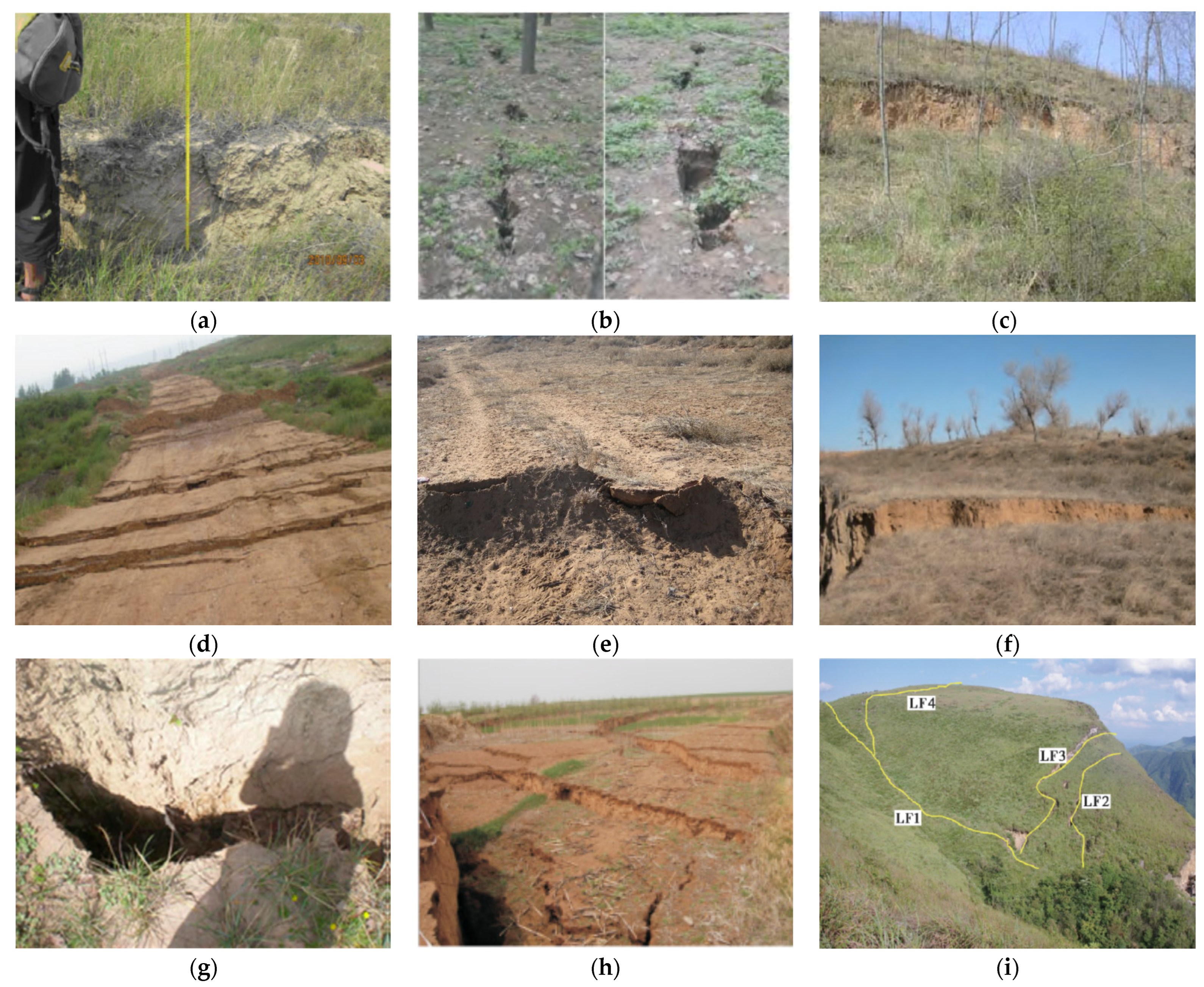
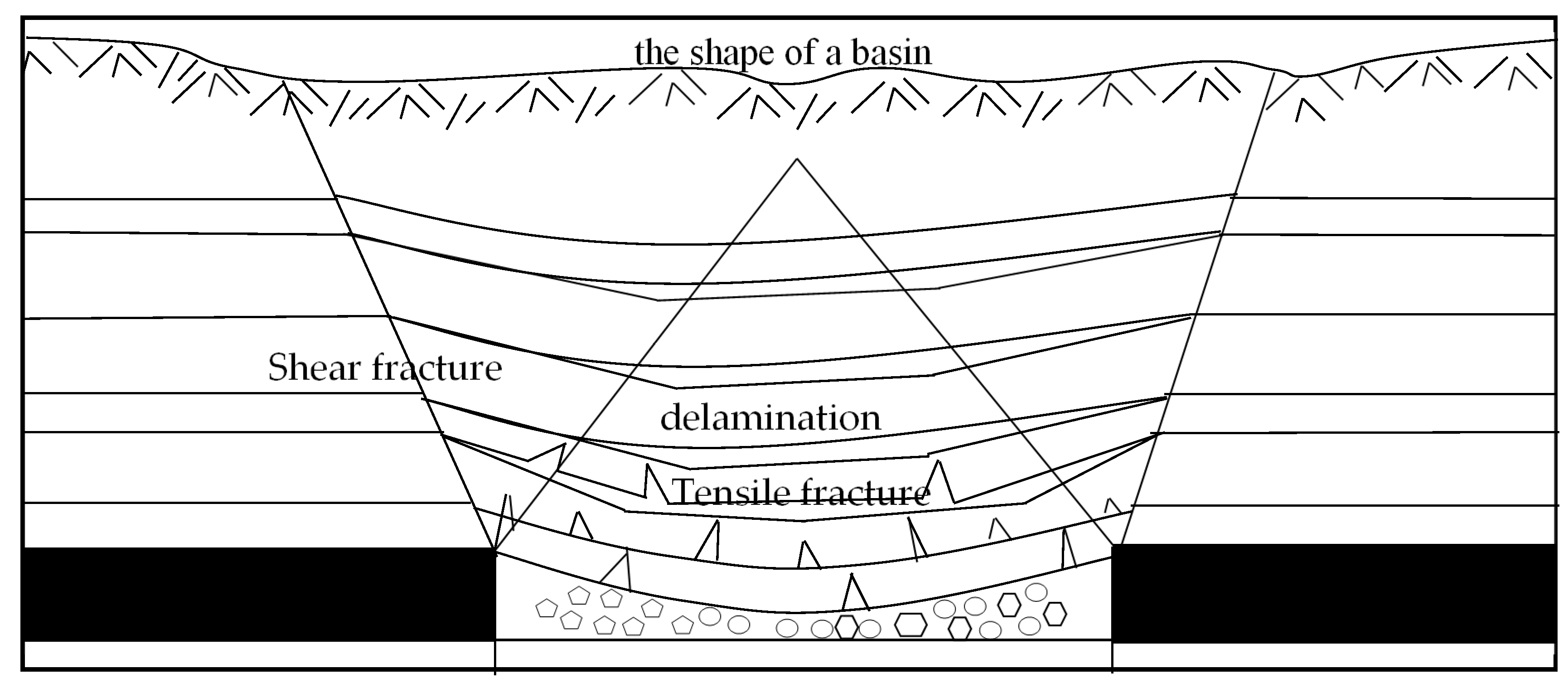
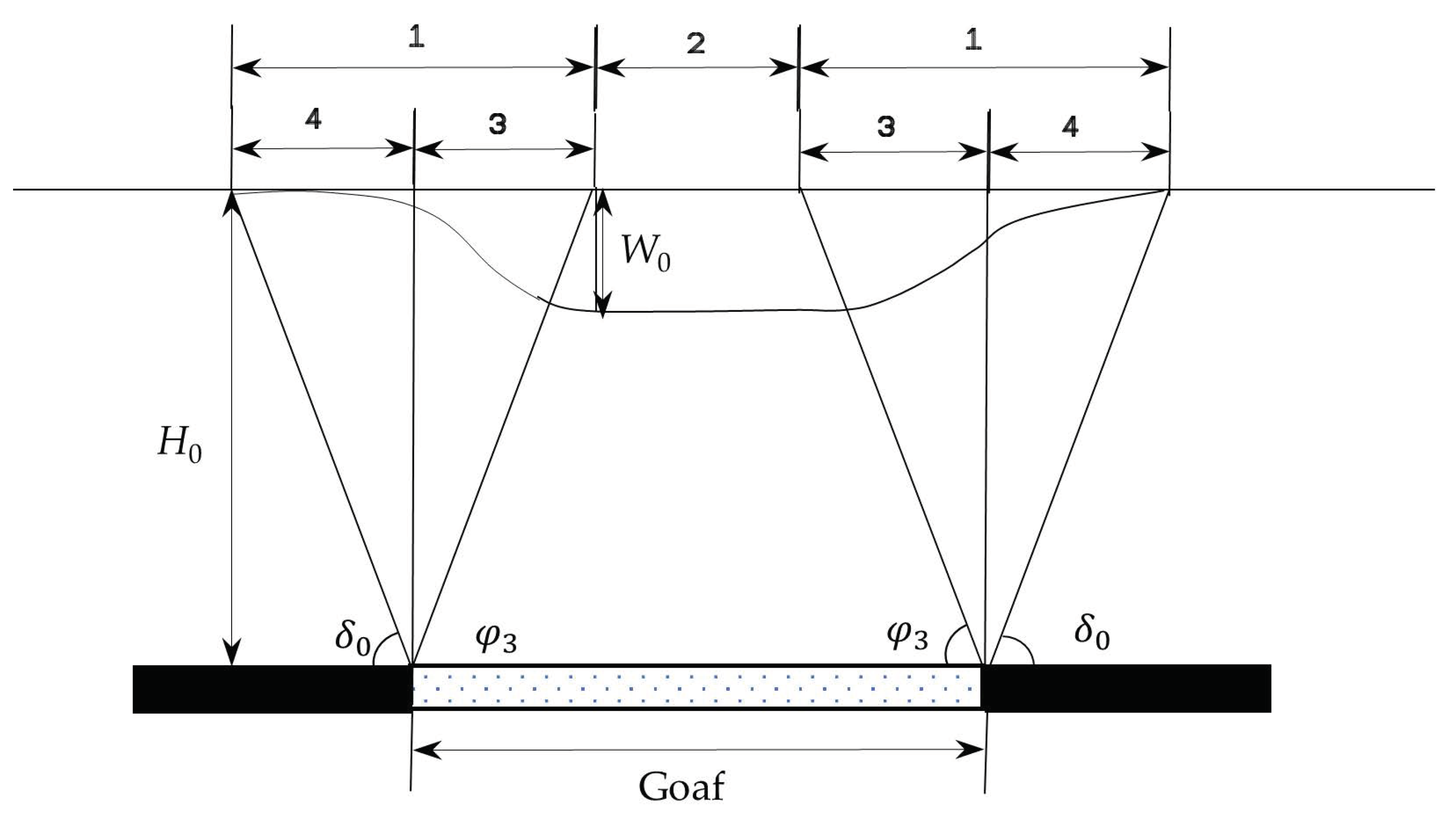
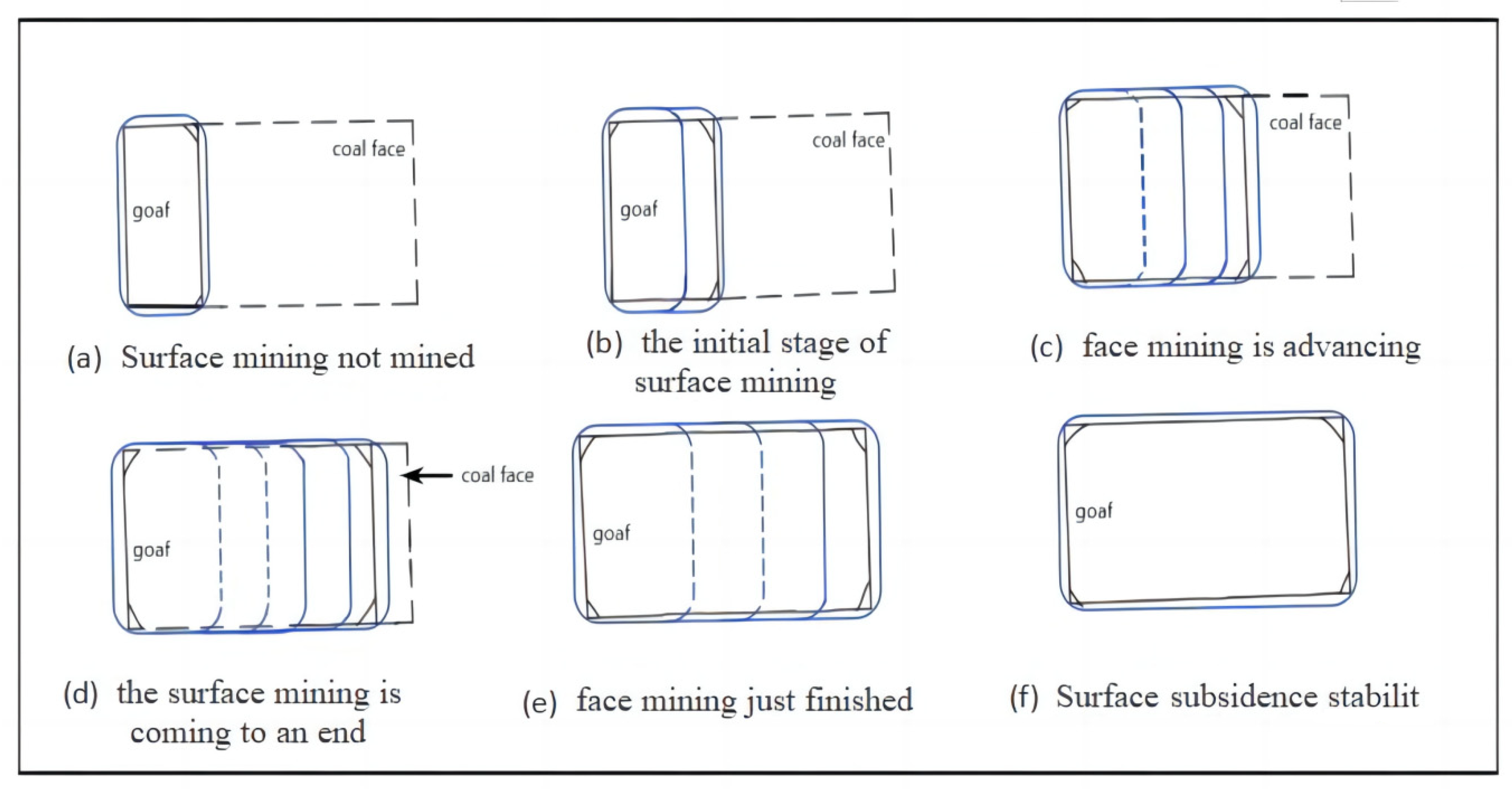


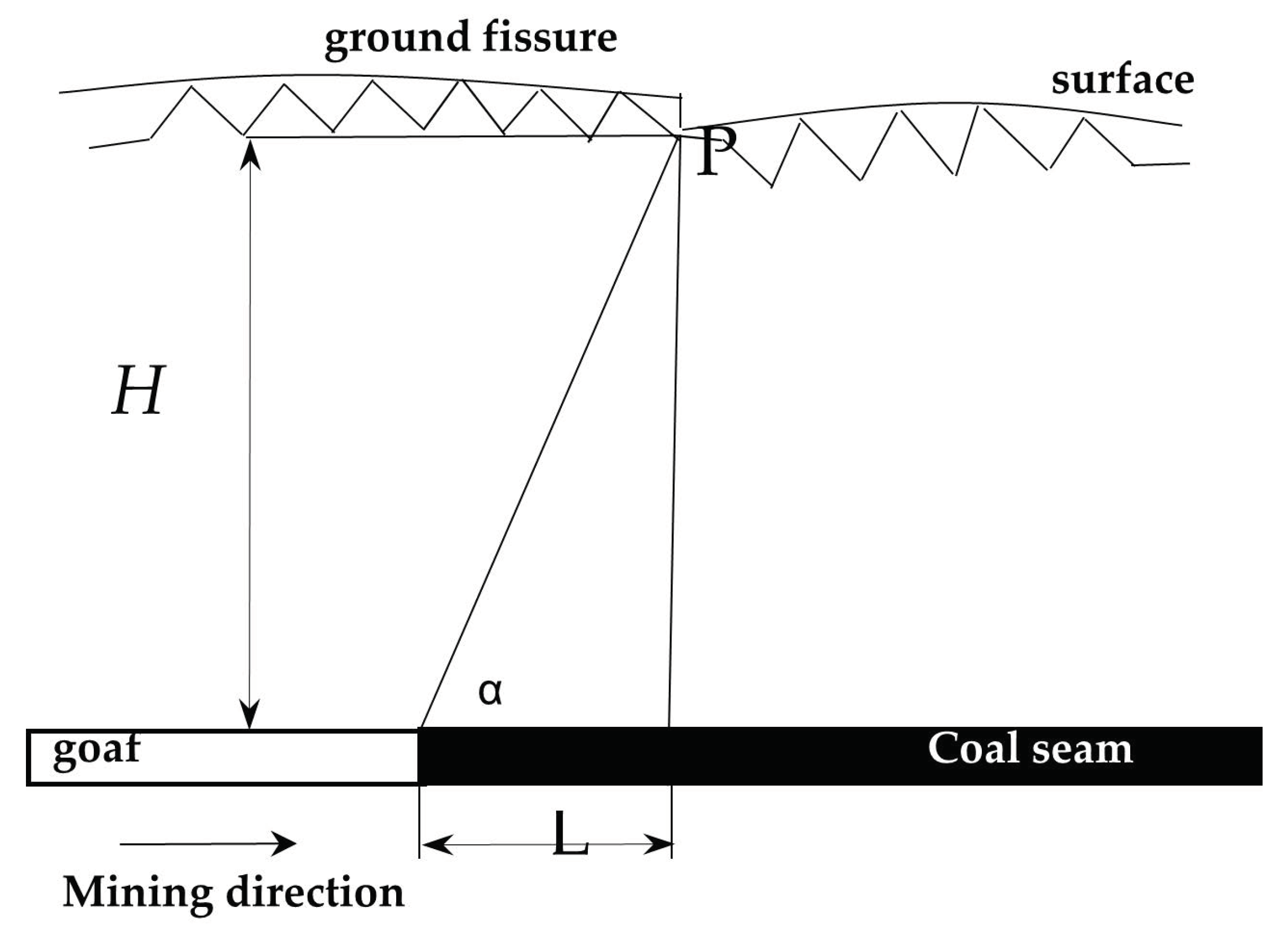
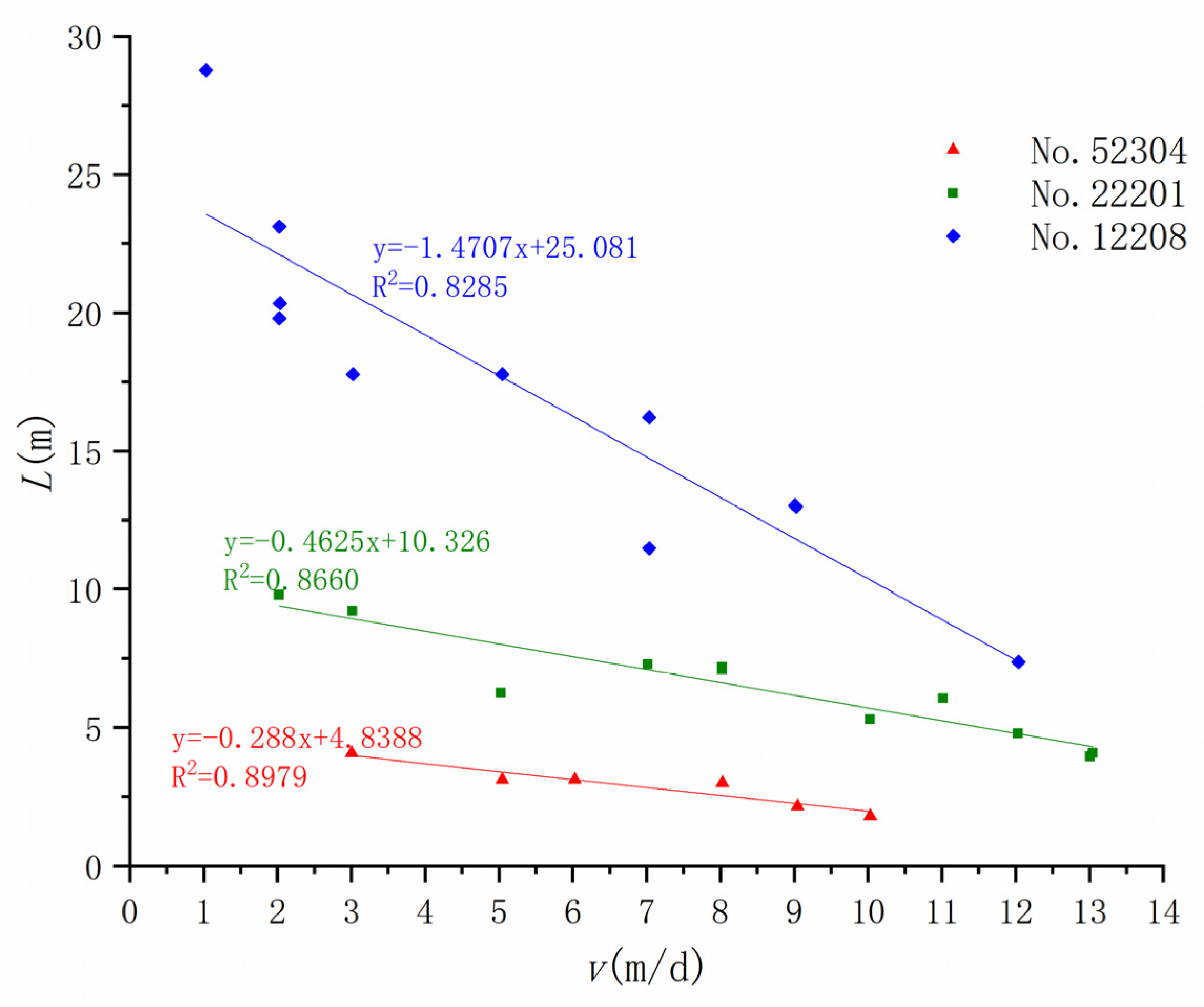


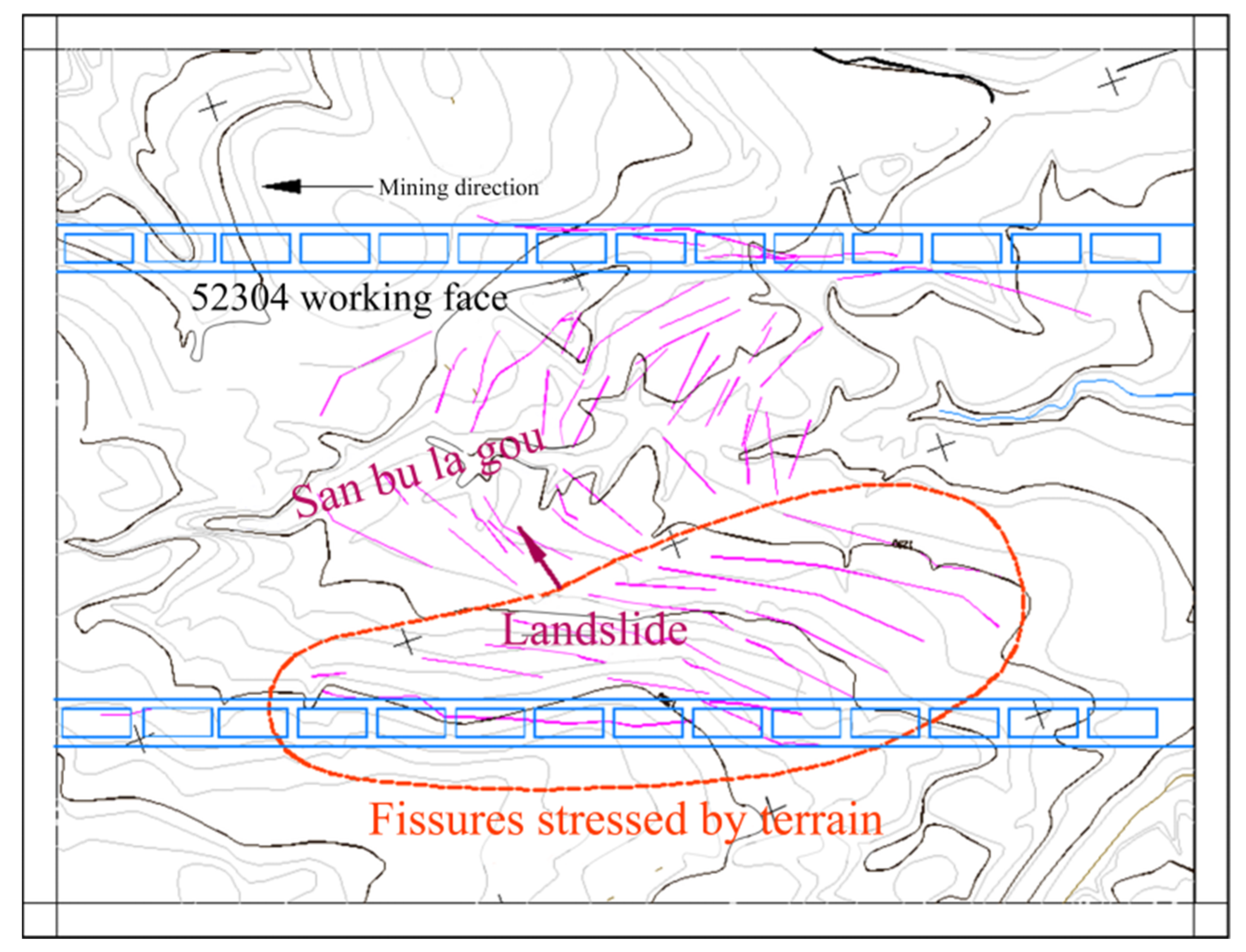

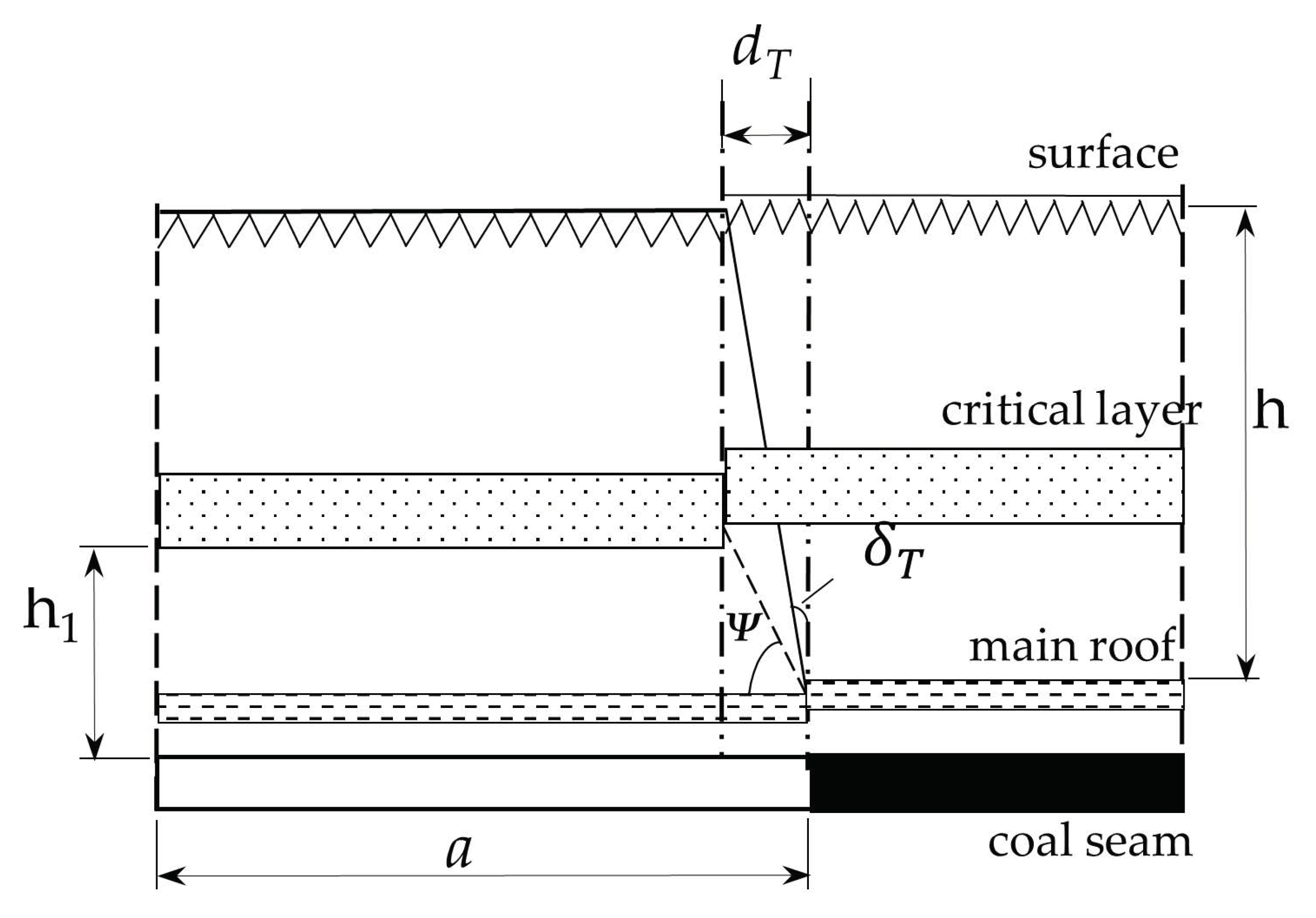

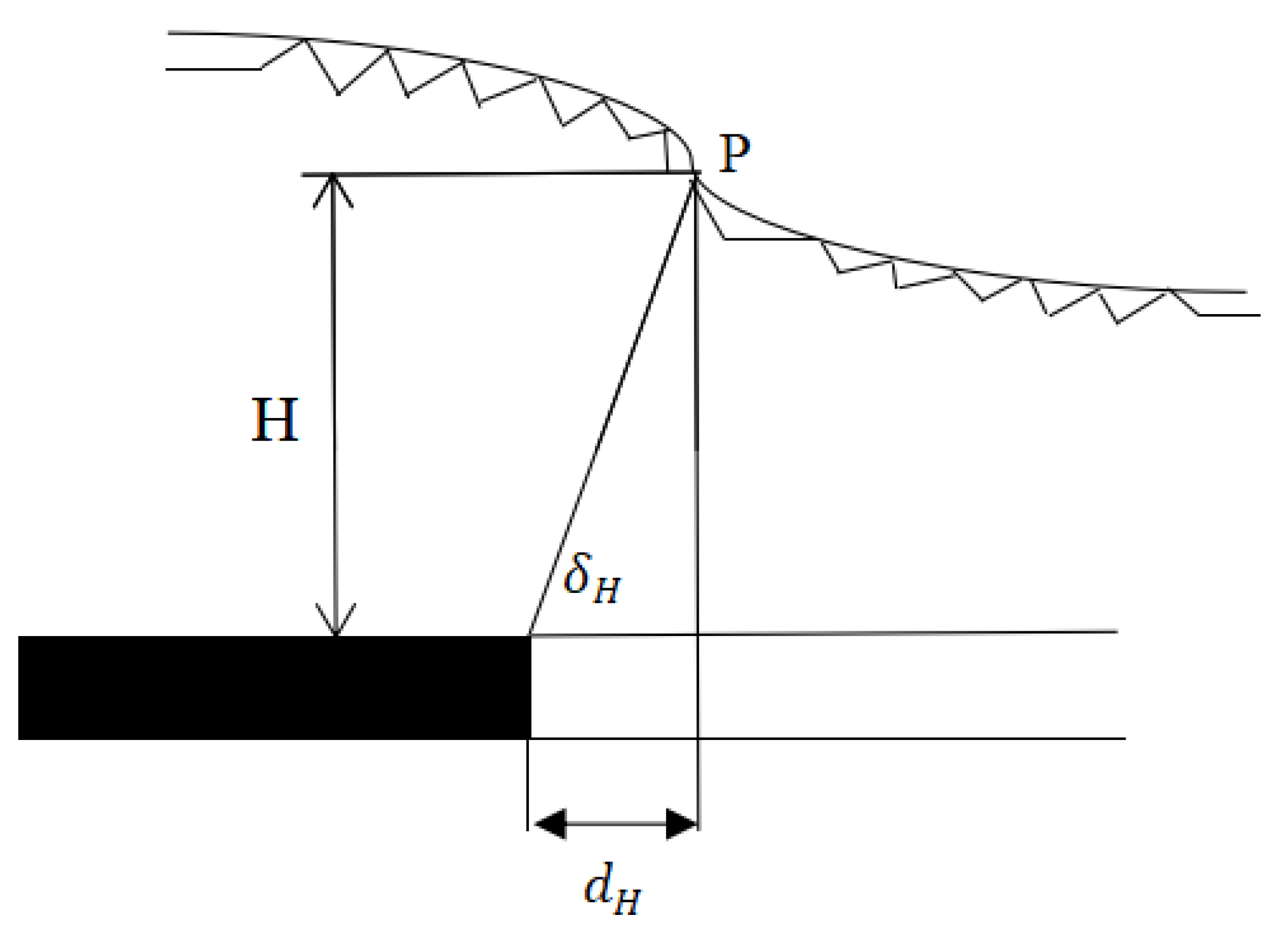
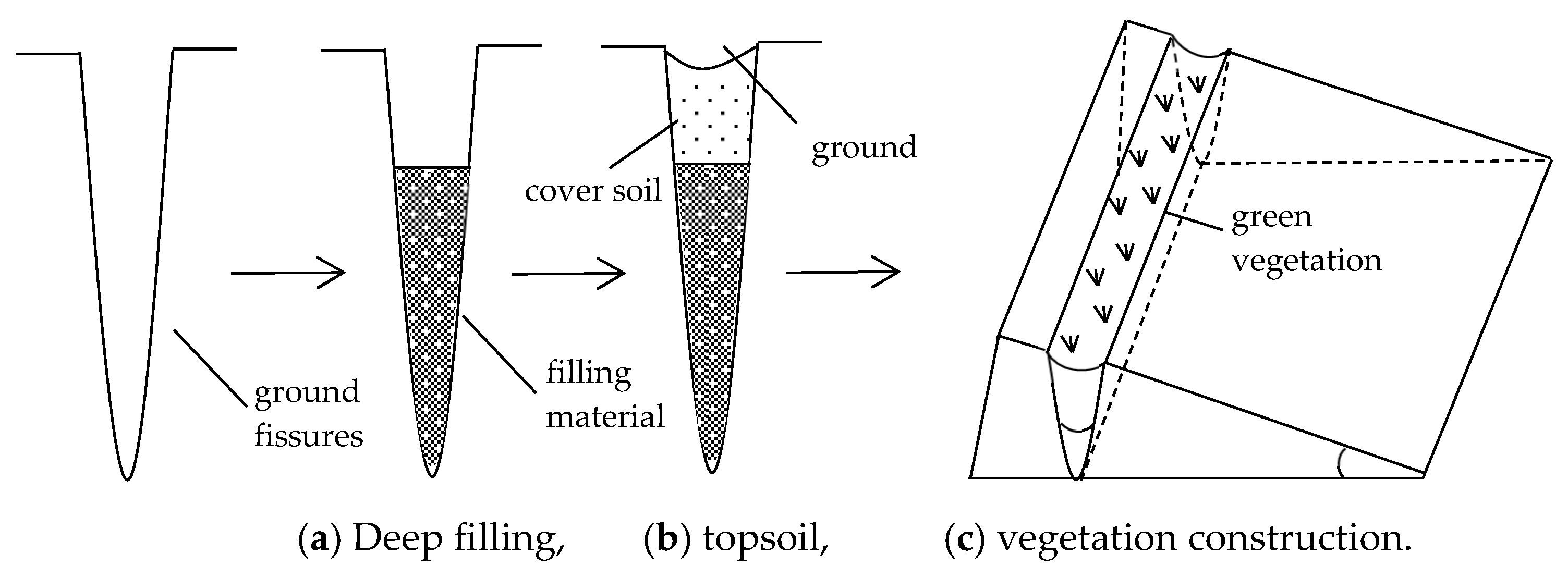
| (a) Basic Conditions of Ground Fissures In Mines. | ||||||
| Number | Time | Province | Mine | Terrain | Forming Reasons | Data Resource |
| 1 | 1975 | Shanxi | Horse Ridge Mine | Mountains | Rock break | WuLixin [21] |
| 2 | 1994 | Shandong | Xinglongzhuang Mine | Plain | Surface deformation | LiLiang [22] |
| 3 | 1999 | Henan | Guozhuang Coal Mine | Plain | Fault activation | Zhou Quanjie [23] |
| 4 | 2001 | Shaanxi | Dayan Kiln Mine | Loess gully | Rock fracture, deformation, slope slip | Fan Limin [4] |
| 5 | 2008 | Shanxi | Wuyang Mine | Hills | Surface deformation | Teng Yonghai [24] |
| 6 | 2009 | Inner Mongolia | Fengshuigou Coal Mine | Loess gully | Slope slip, surface deformation | Zhao Bingchao [25] |
| 7 | 2010 | Anhui | Huainan Mine | Plain | Surface deformation, Rock fracture | Hu Qingfeng [3] |
| 8 | 2011 | Henan | Pingdingshan Thirteen Mine | Plain | Surface deformation | Tao Hailiang [26] |
| 9 | 2011 | Shaanxi | Tongchuan mining area | Mountains | Rock break, slope slip | Yuantao [27] Tang Fuquan [16] |
| 10 | 2012 | Shanxi | Shuozhou mining area | Mountains | Surface deformation, slope slip | Xu Naizhong [28] |
| 11 | 2012 | Shaanxi | Shendong Daliu Pagoda | Loess Plateau | Rock cover break | Liu Hui [15] |
| 12 | 2012 | Shaanxi | Shendong Daliu Pagoda | Loess Plateau | Surface deformation | |
| 13 | 2012 | Shaanxi | Shendong Daliu Pagoda | Loess gully | Surface deformation, slope slip | |
| 14 | 2014 | Shaanxi | Binchang mining area | Loess Plateau | Surface deformation | Tang Fuquan [29] |
| 15 | 2014 | Shanxi | Hezhai Coal Mine | Hills | Rock break | Zhang Wenjing [30] |
| 16 | 2015 | Hebei | Shanhou Mine | Plain | Surface deformation | Zhangfeng [31] |
| 17 | 2015 | Shanxi | Dongpo Coal Mine | Mountains | Surface deformation, slope slip | Gaochao [32] |
| 18 | 2015 | Gansu | Huating mining area | Loess Plateau | Rock break | Dao Naiqin [33] |
| 19 | 2016 | Liaoning | Xiaonan Coal Mine | Plain | Rock fracture, fault activation | Yangfan [34] |
| 20 | 2016 | Guizhou | Jie Niang Ping | Mountains | Slope slip, fault activation | Shi Wenbing [35] |
| 21 | 2018 | Shaanxi | Ningtiaota Coal Mine | Hills | Surface deformation, slope slip | Zhao Bingchao [25] |
| (b) Topographic Parameters of Mine Ground Fissures. | ||||||
| Number | Panel | Mining Depth (m) | Coal Seam Thickness (m) | Maximum Width of Ground Fissure (m) | Maximum Height Difference of Ground Fissure (m) | Maximum Depth of Ground Fissure (m) |
| 1 | 402 | 115 | 6 | 4 | 0.7 | |
| 2 | 4314 | 325 | 8.8 | 0.3 | 0.5 | 3.4 |
| 3 | 2228 | 139 | 3.7 | 0.63 | 0.65 | |
| 4 | 172 | 3.5–5.0 | 2 | 0.73 | 5 | |
| 5 | 7511 | 270 | 6.49 | 0.3 | 0.3 | |
| 6 | 220 | 52.2 | 0.6 | 15 | ||
| 7 | 8104 | 460 | 9.75 | 0.5 | 0.6 | |
| 8 | 11022 | 315 | 5.8 | 0.5 | 3.83 | |
| 9 | D508 | 180 | 2.4 | 1 | 1.9 | |
| 10 | 265 | 14.4 | 0.15 | 1.5 | ||
| 11 | 12208 | 40 | 7.4 | 0.3 | 0.55 | |
| 12 | 22201 | 72 | 3.9 | 0.42 | 0.49 | 5.8 |
| 13 | 52304 | 235 | 6.9 | 0.42 | 1.2 | 6 |
| 14 | B40301 | 350 | 8 | 0.1 | 5.6 | |
| 15 | 2212 | 160 | 2.5 | 0.9 | 0.2 | |
| 16 | 6208 | 360 | 3.2 | 0.2 | 0.05 | |
| 17 | 914 | 265 | 14.4 | 0.71 | 9.84 | |
| 18 | 500 | 22 | 5 | 4 | 66 | |
| 19 | W2–705 | 400 | 2.8 | 6 | >10 | |
| 20 | A9 | 120 | 3.0 | 9.5 | 3.2 | |
| 21 | N1206 | 162 | 5.9 | 0.8 | 1.2 | |
Disclaimer/Publisher’s Note: The statements, opinions and data contained in all publications are solely those of the individual author(s) and contributor(s) and not of MDPI and/or the editor(s). MDPI and/or the editor(s) disclaim responsibility for any injury to people or property resulting from any ideas, methods, instructions or products referred to in the content. |
© 2023 by the authors. Licensee MDPI, Basel, Switzerland. This article is an open access article distributed under the terms and conditions of the Creative Commons Attribution (CC BY) license (https://creativecommons.org/licenses/by/4.0/).
Share and Cite
Li, Y.; Liu, H.; Su, L.; Chen, S.; Zhu, X.; Zhang, P. Developmental Features, Influencing Factors, and Formation Mechanism of Underground Mining–Induced Ground Fissure Disasters in China: A Review. Int. J. Environ. Res. Public Health 2023, 20, 3511. https://doi.org/10.3390/ijerph20043511
Li Y, Liu H, Su L, Chen S, Zhu X, Zhang P. Developmental Features, Influencing Factors, and Formation Mechanism of Underground Mining–Induced Ground Fissure Disasters in China: A Review. International Journal of Environmental Research and Public Health. 2023; 20(4):3511. https://doi.org/10.3390/ijerph20043511
Chicago/Turabian StyleLi, Yu, Hui Liu, Lijuan Su, Sidi Chen, Xiaojun Zhu, and Pengfei Zhang. 2023. "Developmental Features, Influencing Factors, and Formation Mechanism of Underground Mining–Induced Ground Fissure Disasters in China: A Review" International Journal of Environmental Research and Public Health 20, no. 4: 3511. https://doi.org/10.3390/ijerph20043511
APA StyleLi, Y., Liu, H., Su, L., Chen, S., Zhu, X., & Zhang, P. (2023). Developmental Features, Influencing Factors, and Formation Mechanism of Underground Mining–Induced Ground Fissure Disasters in China: A Review. International Journal of Environmental Research and Public Health, 20(4), 3511. https://doi.org/10.3390/ijerph20043511






